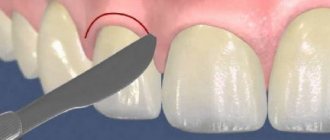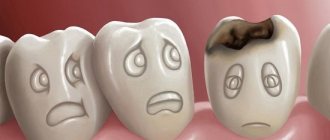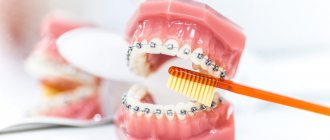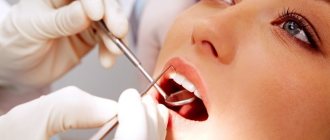1606
The materials from which dentures are made are very important from the point of view of their impact on the dental cavity and on the body as a whole.
Up to 35% of patients with metal dentures experience problems related to their material.
Difficulties are also created by some amalgam fillings, implants, orthodontic devices, and inlays. The name of the main one of these problems is “galvanism”.
Concept and general idea
More than 20 metals are used as materials for orthopedic and orthodontic devices - in pure form or in the form of alloys. Among them are gold, titanium, alloys of iron, nickel, molybdenum and others.
Some of these metals form galvanic pairs with each other - two conductors exchanging electrical charges with each other , as a result of which electrochemical corrosion of one of them occurs, and various elements are released into the saliva, violating its neutrality in relation to the tissues of the oral cavity.
The most active microcurrents are created by bimetallic pairs:
- gold-amalgam;
- amalgam-steel-solder;
- steel-steel-solder.
Reference. Often the words “galvanism” and “galvanosis” are used as synonyms, although in fact they mean different phenomena.
"Galvanism" as applied to dentistry is the induction of electric current in the oral cavity due to an electrochemical reaction occurring between the metals from which orthodontic or orthopedic devices are made. “Galvanosis” is a disease caused by galvanism.
Classification
In medicine, there are two main forms of galvanosis - typical and atypical. They differ in developmental features, characteristic features and the severity of possible consequences. Let's consider each of the forms separately.
Typical shape
The peculiarity of this type of pathology lies in the severity of the accompanying symptoms. But since the signs of galvanosis are pronounced, diagnosing it is quite simple. If the causative factor has not been identified, the disease can last for several months or even years. Due to the fact that galvanosis helps to reduce the protective functions of the patient’s body, other pathologies often develop against its background, for example, herpes, bronchitis, etc. The typical form of galvanosis is very dangerous, as it is often accompanied by serious complications, the most severe of which is cancer .
Typical galvanosis
Atypical form
It is accompanied by an increase in the potentiometric value several times higher than normal, as a result of which symptoms of an atypical form are quite difficult to diagnose. In rare cases, the pathology manifests itself in the form of symptomatic deviations of a single type. As a rule, the duration of the disease is several years, but in more severe clinical cases several years may pass between prosthetics and detection of pathology. Under the influence of certain factors, a transition from an atypical form to a typical one may occur.
Atypical form of galvanosis
On a note! The complexity of atypical galvanosis lies in the severity of its diagnosis. But if the patient is not provided with timely medical care, he may develop another, more serious disease - a malignant tumor that affects healthy tissue in the jaw area.
Prosthetics with different metals
Reasons for development
Electrochemical processes resulting from galvanism lead to changes in the normal environment in the oral cavity and cause pathological changes in its soft and hard tissues.
The reasons for these changes are the following factors:
- The occurrence of currents (microcurrents). Microcurrents of up to 10 µA are considered acceptable and do not cause pathologies.
Some sources indicate more stringent values - up to 5-6 µA. Galvanic current exceeding these values causes inflammatory-keratotic processes in the tissues of the oral cavity. They develop especially intensively if pathological changes already take place. In particular, in the presence of leukoplakia, pathology increases the risk of malignancy of the process. - Changes in the composition of saliva. It can be considered as a complex electrolyte.
It consists of 98% water. The rest consists of mineral and organic substances, amino acids, vitamins, and enzymes. Saliva is normally neutral in relation to the oral cavity. The release of elements of electrochemical reactions into it due to galvanism - copper, cadmium, chromium, tin, mercury (with amalgam fillings), etc. - makes saliva an aggressive environment, leading to undesirable biochemical reactions in the RP. - Toxic-chemical processes in the oral cavity.
- Allergic reactions caused by the body's sensitivity to certain substances formed in the RP.
- Increased acidity of saliva (decrease in pH), provoking the development of inflammatory processes.
The risk of development increases:
- initial defects of prostheses - incorrect selection of metals, leading to the formation of active galvanic couples, a large amount of solder, etc.
- breakage of the prosthesis as a result of use.
Types of galvanization
Currently, galvanic current is used to carry out two cosmetic procedures: iontophoresis and disincrustation. They partially differ from each other in the way they are carried out and the tasks they solve.
Iontophoresis
Iontophoresis involves the influence not only of current, but also of therapeutic drugs introduced deep into the dermis with its help. Cosmetics are polarized, charged, and then enter the cells in the form of a special solution, entering the blood, lymph, and cell membrane. Thanks to the electric current, the active substances penetrate not only deeper, but also have their own, increased activity.
Indications for such a procedure are varied. Cosmetologists perform it for the following types of skin problems:
- Accumulation of toxins, excess fluid, swelling.
- Fine wrinkles, decreased skin elasticity, insufficient production of collagen and elastin.
- Oxygen starvation of cells, disruption of local blood circulation.
- Inflammatory processes, pimples, acne.
- Cellulite.
- Dry skin.
- Dark spots.
Almost any medicinal composition can be used to carry out the procedure. It is selected only by a cosmetologist, taking into account the characteristics of the patient’s skin, as well as individual contraindications. Most often, various acids, vitamins, and natural plant extracts are used in iontophoresis.
Disincrustation
No medications are used for disincrustation; its main indication is skin cleansing. It is carried out using electric current and an alkaline solution, which, under the influence of current in the depths of the dermis and in the sebaceous glands, is converted into soap, a universal cleaning component. The effect eliminates plugs in pores, reduces inflammation, and accelerates regeneration processes. The procedure is indicated for oily skin with enlarged pores, a tendency to form pimples, and acne. To carry it out, solutions of sodium bicarbonate, sodium carbonate or sodium chloride are used.
Signs
Symptoms of the pathology are largely individual in nature - depending on the composition of saliva and the characteristics of the immune system of a particular patient.
The general and dental condition of the patient also influences the symptoms - the presence of foci of inflammation in the oral cavity, periodontal status, psycho-emotional state, hormonal levels.
From the point of view of severity, two forms of pathology are distinguished - typical and atypical. The first is characterized by pronounced symptoms, which greatly facilitates the diagnosis of the disease.
In the atypical form, the pathology is mostly asymptomatic, only sometimes signs appear that allow us to talk about the nature of the disease.
The first manifestations usually appear 1-2 months after orthopedic treatment:
- Burning sensation in the mucous membranes and tongue (most often on the tip or sides). The tongue is a pronounced reflexogenic zone, so it is one of the first to react.
- The taste of metal, salt, acid, which does not disappear after brushing your teeth and eating. H-ions are responsible for this taste, the body’s reaction to the presence of which with a feeling of sourness has long been known.
- Bitterness in the mouth.
- Change or complete loss of taste. In particular, sweet things can be perceived as bitter, or the combination of sweetness and bitterness can create a feeling of saltiness. Sometimes the patient is completely deprived of the sense of taste.
- Changes in salivation, often dry mouth, less often hypersalivation.
- Itching and/or pain in the gums.
- Exacerbation of chronic stomatitis and periodontitis.
The appearance of the mucous membrane is most often unchanged. Less commonly noted:
- hyperemia;
- swelling (usually in areas adjacent to metal structures);
- ulcers and erosions.
Systemic manifestations:
- deterioration of neurological status (general weakness, cancerophobia (fear of getting cancer), irritability, nervousness, headache).
- dysfunction of the central nervous system , manifested, in particular, by dry mouth.
How effective is laser treatment for wedge-shaped dental defects, and how is the procedure performed?
Come here if you are interested in what tablets you can take for toothache during pregnancy.
At this address https://zubovv.ru/lechenie/zubyi/kak-vyiglyadyat-tetratsiklinovyie.html find out whether tetracycline teeth can be whitened.
Manifestations
Hairy leukoplakia of the tongue
Symptoms of galvanosis can be very diverse (depending on the characteristics of the patient’s body):
- feeling of sour, salty in the mouth;
- burning sensation on the tongue;
- metallic taste;
- change in the intensity of salivation;
- systemic disorders (from headaches to weakness, insomnia and lack of appetite).
All of these signs are a consequence of the presence of electric current in the oral cavity, which arose against the background of the interaction of various metals (alloys).
Installation of prostheses made of identical alloys, the best prevention of galvanism
As a rule, the first “signals” of galvanosis in the oral cavity occur several months after prosthetics (if we are talking about the use of stainless steel structures), as well as after repeated orthopedic treatment (if, for example, a new bridge made of a different alloy was installed) . In addition to the “classic” complaints of a metallic or sour taste in the mouth, patients note a perversion of taste sensations or a complete absence thereof.
Galvanosis is also characterized by dry mouth - the occurrence of this symptom is associated with disorders of the central and peripheral nervous system. During a visual examination, the dentist, as a rule, does not detect any pathological changes on the gums and cheeks. The tongue is hyperemic, swollen, enlarged (especially the tip and lateral segments). In the oral cavity, crowns, inlays, and fillings made of dissimilar metals are determined. In places of adhesions, large oxide films are noticeable.
Important! If metallic inclusions that provoke galvanism are not removed in a timely manner, active inflammatory processes begin to develop in the mouth.
The list of these, as a rule, includes gingivitis, papillitis, stomatitis, allergies associated with the release of metal corrosion products into saliva. If galvanism is not treated for several years, patients may experience manifestations of leukoplakia (precancerous lesions of the oral mucosa) and other dangerous inflammatory pathologies that precede the development of tumors.
Diagnosis of pathology
Diagnostics includes anamnesis and questioning of the patient, examination of the oral cavity, and measurement of electrochemical parameters of the oral cavity.
As a result of the medical history and questioning of the patient, the time of onset of symptoms in connection with orthopedic/orthodontic treatment is established.
A visual examination may not detect pathological changes in the oral mucosa. However, the tongue is often enlarged , swollen, and hyperemic (especially in the lateral areas and at the tip).
The presence of metal orthopedic and orthodontic structures with large oxide films in the soldering areas is noted. When you touch the crowns with a metal trowel, pain may occur.
An objective method of diagnosis is hardware diagnostics , which is carried out using special measuring instruments (potentiometer UPIP-601 and PP-63, laboratory pH meter, microammeter M-24, spectrograph ISP-28).
- The tension between the metal elements of the prostheses is measured. Normally, its value should not exceed 50-60 mV.
- The strength of the current flowing between the parts of the prosthetic structures that make up the galvanic pairs is established. Normally, it should not be more than 10 μA.
- The conductivity of saliva is determined - it should not exceed 5-6 µS.
- The pH of saliva is measured. In pathology, there is a slight shift in pH to the acidic side (up to 6.5-6.0 units).
- Using spectral analysis, the composition and amount of microelements in saliva is determined.
Important. Electrical indicators (voltage value, microcurrent strength) and the severity of the clinical picture do not clearly correlate. While the qualitative and quantitative composition of the elements found in saliva directly affects the clinic.
In case of pathology, differential diagnosis is important, including the exclusion of allergic stomatitis, stomalgia, glossalgia. In this regard, it may be necessary to consult doctors of other specializations - oncologist, gastroenterologist, allergist, psychotherapist.
According to indications, immunological studies, CT scan of the skull (facial part), and biochemical blood test can be performed. A general blood test is not informative regarding galvanosis.
Diagnosis of galvanosis of the oral cavity
Diagnostic measures are carried out using special medical measuring instruments. In this case, the potential difference between different parts of the prosthesis or between the crowns is measured. The procedure is carried out repeatedly in accordance with a given algorithm.
And since the current is very low, such devices are therefore super sensitive. The diagnosis is made based on the maximum values. Thus, with the help of devices, it can be revealed that the true cause of oral discomfort lies precisely in galvanism.
In addition, a number of studies are being conducted:
- General analysis of urine and blood.
- The presence of an allergy to metals is determined.
- Biochemical study of saliva and blood.
- Measurement of saliva acidity.
During a visual examination of the patient, pathological changes in the mucous membrane are not always revealed, which usually occurs under the influence of metal structures in the oral cavity. Galvanosis, however, can manifest itself as an enlargement of the tongue. Oxide films are also visible on orthopedic products at soldering points.
Treatment tactics
Treatment of galvanosis consists of eliminating the causes that cause it. This means replacing metal dentures with non-metallic structures, and amalgam fillings with composite or cement ones.
However, you should not count on a quick effect from treatment. The result of treatment may not appear immediately, but several months after it.
Simultaneously with the replacement of metal prostheses, other therapeutic measures are carried out. In general, therapy looks like this:
- Examination of the oral cavity , assessment of its condition in terms of the presence of dental pathologies, metal orthodontic and orthopedic devices.
- Removal of metal prostheses , the appearance of which suggests an electrochemical process (oxide film, metal corrosion).
- A pause necessary to check the effect of removing the prosthesis. It may take several months, since the result usually does not come immediately. At this time, treatment of identified pathologies can be carried out, as well as restorative and immunostimulating therapy.
- Re-prosthetics. The issue is resolved only after all signs of pathology have disappeared. As an alternative to metal prostheses, non-conducting composite or ceramic products can be used.
Let's figure out together whether it is possible to treat teeth for pregnant women, and in which trimester is better.
In this publication, we will find out why a tooth may react to heat.
Read here how to get rid of dental phobia.
Stock
-25%
Removable denture for 1 jaw RUB 20,000.
15,000 rub.
get -20 %
Dental implantation RUB 20,000.
25000 rub. 20,000 rub.
get -37 %
Osstem dental implant and metal-ceramic crown RUB 63,000.
40,000 rub.
get -50 %
Manufacturing of removable denture Acry Free 40,000 rub.
20,000 rub. get
Prevention
One of the main measures to prevent galvanosis is to inform the orthopedic dentist before the upcoming prosthetics about what metal prostheses have already been installed and how the body reacts to them.
The doctor should know whether his patient has encountered galvanosis before, whether he has experienced any symptoms that usually occur with galvanism - burning and redness of the tongue, dry mouth, inflammatory processes, deterioration of well-being.
In the presence of such symptoms, it is advisable to give preference not to soldered, but to solid-cast prostheses made from homogeneous metals, or, even better, from non-metallic ones (ceramics or composites).
Having metal dentures, it is advisable to visit the dentist regularly, at least 2 times a year, to examine the oral cavity in order to determine the condition of the dentures and their effect on the mucous membrane of the oral cavity.
Contraindications
Despite the fact that electrical therapy is classified as a safe and minimally invasive procedure, there are still limitations to its implementation. Cosmetologists and physiotherapists do not advise resorting to such effects when:
- Pregnancy.
- Exacerbation of chronic diseases.
- The presence of metal implants, gold threads in the potential impact area.
- Oncology.
- Individual intolerance to electric current.
- Allergies to drugs administered during the procedure.
- Feverish state.
- Circulatory disorders of 2 or 3 degrees.
- Atrial fibrillation, diseases of the cardiovascular system.
- Skin diseases, open wounds and damage to the integrity of the skin in the problem area.
- Tuberculosis.
- Epilepsy and mental disorders.
Procedures should be postponed at high blood pressure until the patient’s condition normalizes.
Price
The cost of treating pathology is difficult to predict, since it completely depends on the specific clinical situation - the number and complexity of prostheses, the type and form of pathology caused by galvanism, and the general health of the patient.
We can definitely only talk about the cost of the first consultation with a specialist, which is usually about 1000 rubles. Further costs depend on the complexity of the prosthetics and diagnostic results.
The video provides additional information on the topic of the article.
How to recognize galvanism in yourself
If you recently visited the dentist and within a few days after having prosthetics with metal-ceramics or another prosthesis containing metal, you felt the symptoms described below, then it is very possible that you have developed galvanic syndrome. However, its symptoms can be observed six months or even a year after installation of the prosthesis. Let's describe them:
- the presence of a constant unpleasant taste in the mouth, the appearance of which does not depend in any way on food intake,
- swelling, itching and burning of the mucous membrane and tongue,
- There is a distortion in the taste of foods due to disruption of the receptors: sour, sweet, salty, bitter are perceived differently. Uncharacteristic shades of aftertaste arise: for example, when eating sweet food, a slight bitterness is felt. A person may simply cease to distinguish between flavors, then food becomes monotonous and bland,
- the functioning of the salivary glands is disrupted, which may result in dry mouth,
- A white-gray coating may form on the mucous membrane.
This is interesting: Treatment of tooth pulpitis - a biological method
If measures are not taken in time, then non-standard taste sensations can cause more unpleasant consequences: headaches, fatigue, a decrease in the body’s immune forces and performance, and a general deterioration in well-being. Sleep is also disturbed. In extreme cases, galvanism can lead to mental disorder.
The severity of the symptoms of the disease depends on the form of its course. There are two types of galvanism: typical and atypical. The first form is characterized by pronounced symptoms; in this case, the diagnosis is much easier to make and treatment is easier to tolerate. The atypical form is called latent because it is characterized by lethargy of symptoms.
Reviews
If you have encountered such a phenomenon as galvanism, please share it with visitors to our site. How did you feel and how did you manage to get rid of this problem?
Your comment at the bottom of this page can be of practical benefit to people who are encountering pathology for the first time.
If you find an error, please select a piece of text and press Ctrl+Enter.
Tags: teeth, oral cavity
Did you like the article? stay tuned
No comments yet









